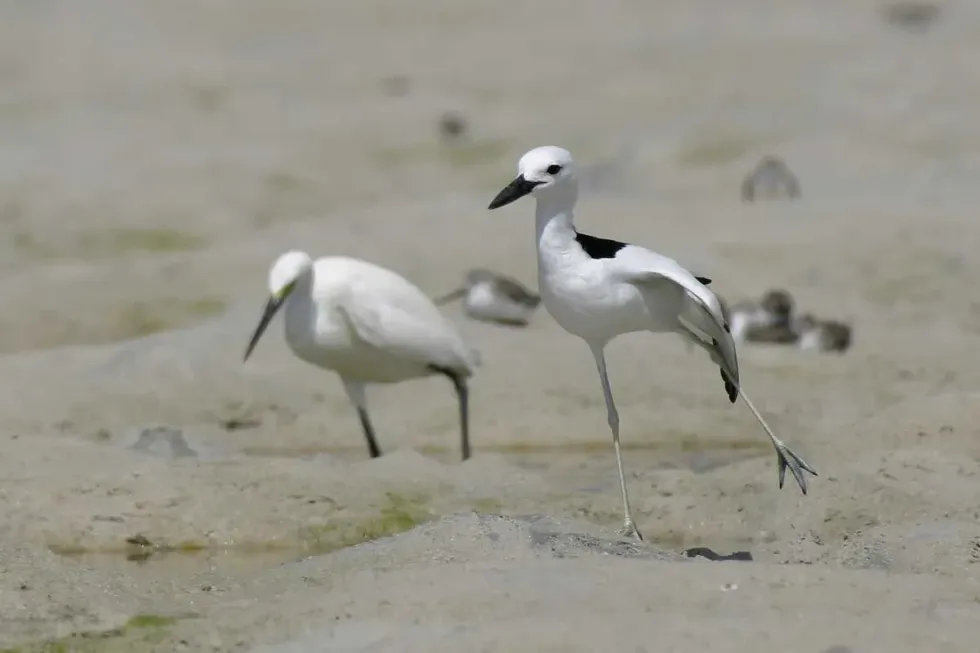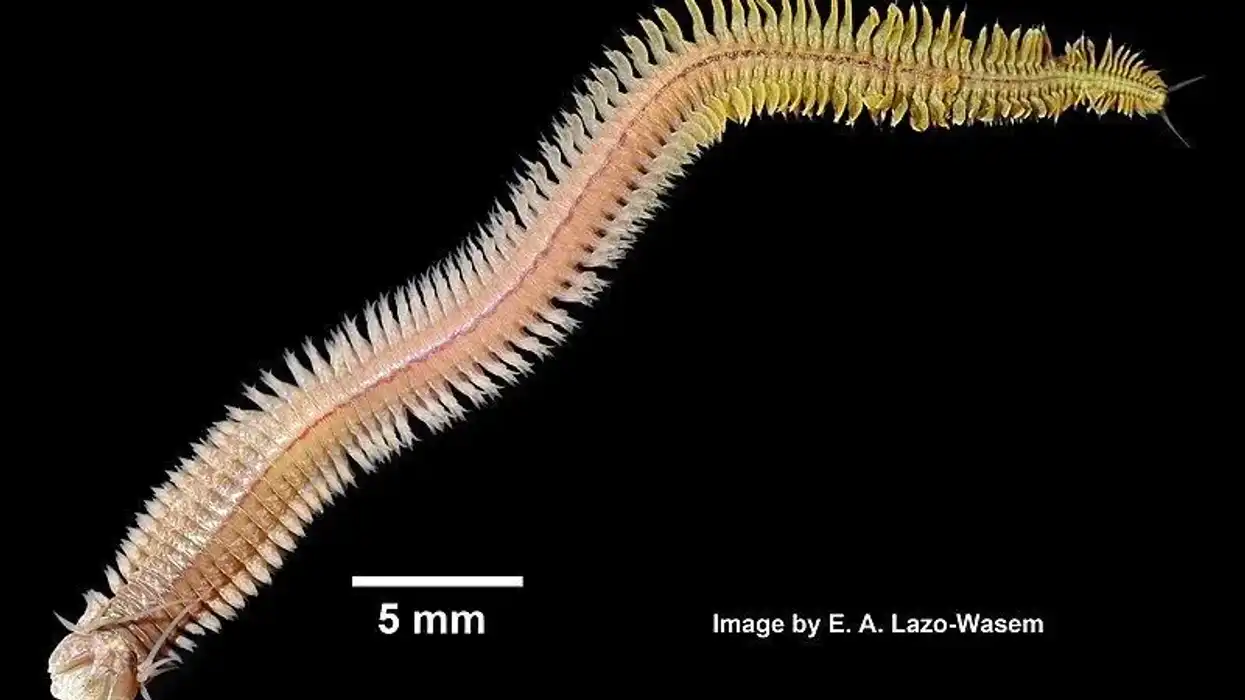The crab plover is scientifically called Dromas ardeola. It is a bird that belongs to the family Dromadidae. It is closely related to a group of birds called waders, which are birds found along shorelines.
Crab plovers have been classified under the order Charadriiformes. It was named in 1805 in India by Paykull.
Their breeding and nesting habits are most peculiar and these have prodded many taxonomists to consider the crab plover as belonging to a monotypic family. Some taxonomists relate the crab plover taxonomy to the pratincoles due to the presence of thick knees. Some taxonomists believe they have a relationship with auks and gulls.
It is the only member of the genus Dromas. They are most commonly grouped under the suborder Charadrii along with other waders and shorebirds.
You may also check out the fact files on blue jay and greater flamingo from Kidadl.
Crab Plover Interesting Facts
What type of animal is a crab plover?
The crab plover is a bird that belongs to the family Dromadidae.
What class of animal does a crab plover belong to?
This bird belongs to the class of Aves within the animal kingdom. It is from the Dromadidae family.
How many crab plovers are there in the world?
The total global population of the crab plover, Dromas ardeola is approximately 60,000-80,000 with the greatest density in and around Tanzania.
Where does a crab plover live?
Crab plovers are peculiar long legged wading birds of the world that are predominantly found along sandy coastlines, on islands, intertidal mudflats, sand flats, estuaries, lagoons, and exposed coral reefs. During breeding, however, crab plovers have a preference for nesting along sand dunes and sandy islands that are suitable for the formation of burrows.
Geographically, their distribution is along maritime coasts and islands. They occur along the coasts of the Indian Ocean, the northern coast of the Arabian Sea, the Red Sea, the Persian Gulf, and the Andaman And Nicobar Islands. The distribution of the crab plover is very localized, with only nine nesting colonies being known to the world.
What is a crab plover's habitat?
Crab plovers are coastal marine species that are found in desert and semi desert areas. They are predominantly found along sandy coastlines, on islands, intertidal mudflats, and sand flats, estuaries, lagoons, and exposed coral reefs.
Their activities do not extend beyond approximately a kilometer from the coast due to the plentiful supply of crustaceans here.
Flocks of crab plovers form a characteristic V shape. During breeding, however, crab plovers have a preference for nesting along sand dunes and sandy islands that are suitable breeding sites for the formation of burrows.
The crab plover range is along maritime coasts and islands. They occur along the coasts of the Indian Ocean, the northern coast of the Arabian Sea, the Red Sea, the Persian Gulf, and the Andaman And Nicobar Islands. The distribution of the crab plover is very localized, with only nine nesting colonies being known to the world.
Who do crab plovers live with?
Crab plovers are sociable birds that usually feed in large groups of 30-40. Outside the breeding season, however, repeated rapidly flocks of approximately 400 in number are common.
How long does a crab plover live?
The crab plover, Dromas ardeola can live for 9-10 years.
How do they reproduce?
Breeding among crab plovers typically occurs around the Arabian Sea of Pakistan, Gulf of Oman, Somalia, Tanzania, the Red Sea, and the Persian Gulf.
These birds prefer the hottest and the driest times of the year to breed and nest. The breeding season most commonly begins in mid May, but can ordinarily occur any time between the month of April and August.
An important feature that differentiates the crab plover from waders is the fact that it has nest sites in burrows located in sandy banks, most commonly in the region of the Red Sea.
The crab plover, Dromas ardeola, practices colonial breeding, nesting in colonies that go up to a number as large as 1500 pairs. The female lays a single large white egg into a burrow.
Occasionally two eggs may be laid. The timing of this nesting carefully coincides with the time in which there are plentiful crabs available for feeding and these animals nest for several days.
The burrows are typically angled downwards and then curve upwards to end in a chamber like area a short distance from the surface. This chamber acts as an area of insulation for the egg, thereby protecting them from extremely hot temperatures that are typical during the breeding season.
The burrows in nest sites protect the young ones from the extremes of temperature as well as from any nesting predators in the area.
The temperature of this burrow is optimal and is due to solar radiation.
The parents are therefore allowed to leave their eggs for extended periods of time, as long as three to four days. In comparison to other bird species, the egg of the crab plover is one of the largest according to its body mass index.
Upon hatching, the chicks are incapable of walking efficiently on their own for the first few days. They remain in the nest for these first several days and food is brought to them there. This food consists mainly of live crabs and small fish.
This property gives them the title of being nidifugous (animals that leave their nests shortly after their birth) waders. This parental care continues for a long period even after the chicks become fully fledged.
Adults do not regurgitate the food but pass on pieces of the mashed prey to their young ones. Older chicks are given their prey as a whole. Both males and females are responsible for this parental care.
Juvenile crab plovers are characteristically uniformly gray or brown. This color typically remains for approximately a year. They have a stout bill and may closely resemble a gull.
What is their conservation status?
The total global population of the crab plover is approximately 60,000-80,000 observed on wintering grounds, with the greatest density in the regions in and around Tanzania. The crab plover is a stable population that has been classified as Least Concern on the IUCN Red List.
The majority of the crab plover population occurs near regions containing oil fields. This is why oil spills are among some potential risks to this species. Other potential risks include the widespread destruction of mangrove and other coastal habitats.
This is a result of pollution and human development. Another potential risk factor for the endangerment of the crab plover is the introduction of nesting predator species.
If a catastrophic event were to occur, it would be comparatively difficult for the crab plover species to recover. This is due to their low rate of reproduction, small population size, and narrow habitat requirements. This is why this species of bird requires careful monitoring and surveillance to ensure its continuing existence.
The crab plover is one of the birds to which the Agreement on the Conservation of African-Eurasian Migratory Waterbirds applies. Although it has been classified as Least Concern on the IUCN Red List, this beautiful species of shorebirds must be carefully monitored.
This is due to their low reproduction rate and small population size which makes them prone to endangerment.
Crab Plover Fun Facts
What do crab plovers look like?
The crab plover Dromas ardeola has a long neck that accentuates its upright posture. They may have a hunched posture on land. The bird measures around 15-16 in (38-41 cm) in length and weighs approximately 0.5-0.7 lb (230-330 g). It has a wingspan of 30-31 in (75-78 cm).
Its plumage is white except for black on its back (the mantle) and the primary feathers of the wings. It has a pale gray colored tail. Juvenile crab plovers have a pied white plumage, where the crown, hindneck, mantle, lesser and median coverts are also gray.
Its dagger like black bill is unique among waders. This heavy bill is strong and gull like. It is specially designed to pound the hard shells of its prey like crabs, mollusks, and other crustaceans.
The crab plover’s legs are blue to grey in color. These long legged birds have partially webbed toes with a well-developed first toe, which is useful for digging their nesting burrows in sandy areas. The gray colored legs have thick knees.

How cute are they?
These birds with partially webbed toes and thick knees are quite cute.
How do they communicate?
Although they are known as tame birds, crab plovers are noisy birds calling frequently. It produces a sound likened to a “ka”, that closely resembles that of the bar tailed godwit.
The difference between the two is that the sound that the crab plover makes is repeated frequently on their breeding sites and in quick succession. The usual call is heard over breeding sites and wintering grounds.
When they occur in flocks, they produce a characteristic ‘whinnying’ sound that rises. During the breeding season, crab plovers produce a characteristic whistling “kew ki ki” note.
How big is a crab plover?
The shallow water bird measures around 15-16 in (38-41 cm) in length and has a wingspan of 30-31 in (75-78 cm).
How fast can a crab plover fly?
Information on this is not available.
How much does a crab plover weigh?
The average crab plover weight is 0.5-0.7 lb (230-330 g).
What are the male and female names of the species?
Males and females are called crab plovers and have no distinct names.
What would you call a baby crab plover?
A baby of this family is called a nestling if it hasn't left the nest as yet and fledgling if it has.
What do they eat?
They have a standard diet of eating crabs, small bivalve mollusks, small fish, marine worms, and various other crustaceans.
Are they friendly?
Crab plovers do not interact with humans as they are mainly found in relatively harsh and remote areas.
Would they make a good pet?
No, the plover crab needs to be in the wild.
Did you know...
A male and female plover crab resemble each other very closely. It is not easy to distinguish a male crab plover from a female crab plover. The male has a heavier and longer bill than the female, but the difference ends there.
After the breeding season and egg laying are over, the crab plovers begin their migration and disperse along the Indian Ocean. They reach as far as the islands of Madagascar, Sri Lanka, and Tanzania.
How do crab plovers eat their prey?
Their heavy bill is specially designed to pound the hard shells of the animals that make up their diet. Smaller crabs are swallowed whole.
Other diet options for the crab plover include crustaceans other than crabs, marine worms and other invertebrates found in the areas they inhabit. Small fish may be fed to the young ones when they are still in their nests.
What makes crab plovers different to other wading birds?
The crab plover Dromas ardeola is unique among waders as it has nest sites in burrows located in sandy banks, most commonly in the region of the Red Sea. These birds use the warmth of the ground to incubate the eggs.
The young chicks of this species are also unique among waders because they remain in their nests several days after hatching .
Here at Kidadl, we have carefully created lots of interesting family friendly animal facts for everyone to discover! For more relatable content, check out these kestrel bird facts and Fischer's lovebird facts pages.
You can even occupy yourself at home by coloring in one of our free printable Crab plover coloring pages.









